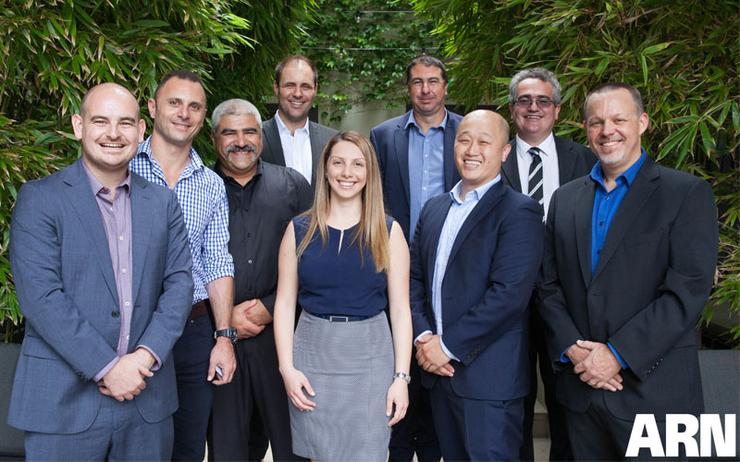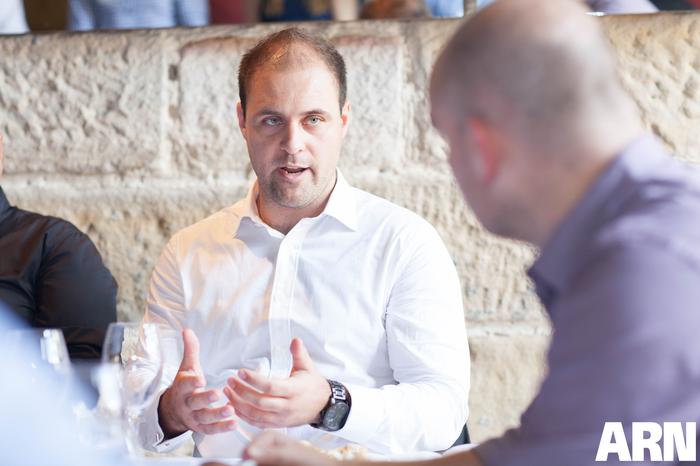
James Henderson (ARN); Itzik Swissa (F5 Networks); George Kassianou (ACK IT Services); James Ormesher (VMtech); Claudia Couzi (AC3); Craig Sims (CCNA); Tony Lam (Dicker Data); Nick Beaugeard (HubOne) and Ryan Delany (Trend Micro)
“But there needs to be more available and on offer than that because partners must provide customers with comfort around everything that they do.
“Those partners will win. I use the word comfort because that’s what customers want, they want to know service providers have everything covered.”
Customer demands
As digitalisation and technological innovation change the role of the CIO, leaders are rapidly scaling digital businesses, making 2018 a defining moment for customers who don’t want to be left behind in an increasingly competitive market.
In the year ahead, technology leaders are expected to transition from delivery executive to business executive, from controlling cost and engineering processes, to driving revenue and exploiting data.
“We’re seeing approaches in market that are business outcomes focused whereby customers are separating out the technology from the outcome,” Ormesher added. “There’s a real drive to aggregate, centralise and bring innovation inside the organisation because it’s difficult for customers.
“The market is filled with new technologies and vendors, so we are spending time with customers — within the managed services contract — to conduct quarterly reviews around innovation and new technologies.”
Because while the customer today demands providers meet more stringent requirements - such as always-on, speed of provisioning, and the ability to adjust service requirements more quickly - Ormesher said MSPs must now bring more to the table in terms of innovation.
Failure to do so will result in almost immediate irrelevance.
“Customer’s don’t just want providers to keep the lights on, they want to be taken to the next level,” he added. “As an MSP, if you are just keeping the lights on, then you will become redundant pretty quickly in the eyes of the customer.
“Businesses today can go out to market very quickly and research their own information and make decisions. We view a managed services contract as the start of our engagement, and we ensure our customer continues to innovate going forward.
“Customers are now demanding this approach in the contract which means we must constantly research what is coming next and provide that information back to the business.”

In observing a changing managed services scene across Australia, Couzi said businesses previously outsourced technology services in a bid to cut costs, with the market evolving considerably during the past 12-24 months.
“That proved too much risk and customers at the time still weren’t receiving a better service,” Couzi recalled. “So then the market moved to businesses managing IT to maintain an element of control and governance.
“But now customers are looking to MSPs to become experts in areas of the market that they can’t keep up with, whether that be current or emerging technologies trends, or an external threat such as cyber security. Customers want to be the experts without investing time and people into technologies.
“Therefore, we can provide learnings, insights and expertise to provide information and advice in a compressed timeframe. This is a huge value proposition for MSPs today.”
From an investment perspective, technology shifts are not only changing what customers are consuming, but also the way MSPs sell and influence the end-user, as buying behaviours evolve alongside increased end-user education.
“Customers are more knowledgeable today,” CCNA director Craig Sims added. “In the old days, when you put a solution together for the customer, they understood 20 per cent of the offering up front and you had to explain the other 80 per cent later.
“That has completely flipped in the market now. Customers today already know 80 per cent of the solution and we’re just pulling everything together for the last 20 per cent.”
Consequently, customers are now defining business outcomes and requirements, taking control of the conversation to drive innovation throughout the organisation. But such customer knowledge, for an MSP, comes at a price.
“The problem resides in the Qantas lounge because we’re dealing with CEOs that receive all their IT advice in a magazine,” ACK IT Services managing director George Kassianou said. “They believe they can address all of their issues by sending everything to the cloud, because they read it in a magazine.
“But when you’re in front of the customer and you’re trying to explain the difference, that’s when challenges arise because sometimes these perceived informed buyers are misinformed. Customers see a silver bullet and they run for it but as an MSP, we know that it won’t solve the problem.”

Specific to the small business sector, HubOne CEO Nick Beaugeard said customers are seeking out specialised solutions, solutions capable of addressing specific niche needs.
When becoming specialised however, MSPs mustn’t become vague, instead deep diving into the heart of an industry, become submerged in sub- sectors and inundating customers with unique expertise.
“Customers align with providers that carry a deep industry focus,” said Beaugeard, in aligning with the accountancy industry across Australia and New Zealand. “We’ve excelled within the accounting vertical because we have tailored solutions and that’s a huge drawcard for the customer because it’s half the battle already won.
“Customers are also looking for someone who is a specialist in their industry to deliver a whole of business outcome.”
In looking ahead, the role of the CIO — and the tech buyers operating on the peripherals of the IT department — will grow and develop as digital business spreads, creating a “more for less” expectation of MSPs.
“If you’re not engaging with your customers regularly, then you are going to lose them,” Sims added. “A lot of the managed services agreements being pushed onto us from the customers now have 12 month renewals.
“Therefore, if you’re not servicing the customer efficiently throughout the year, you will be replaced. Customers know that they are paying monthly fees and nine months into that contract, if you’re not servicing them you will get caught out quickly.”
Echoing Sim’s observations, Swissa acknowledged that customers in Australia are “very vicious” when it comes to technology loyalty, with a strong tendency to switch providers if high standards are not being delivered upon.
“If they are under-serviced, they will skip and move to another MSP,” Swissa added. “We see that happening all of the time. Partners must put a lot of effort into keeping the customer happy.”
Customer risk
Despite the C-suite in business organisations today recognising the fast pace of technological developments, executives grapple with the key question: what happens next and when?
Read more on the next page...




